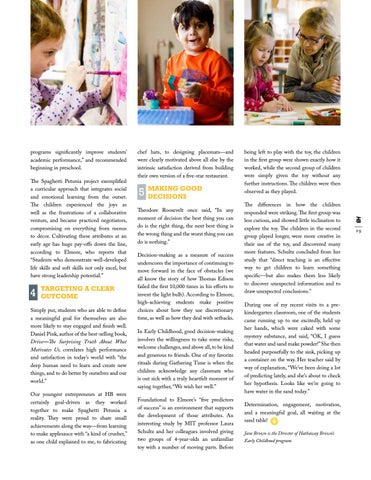programs significantly improve students’ academic performance,” and recommended beginning in preschool.
TARGETING A CLEAR 4 OUTCOME Simply put, students who are able to define a meaningful goal for themselves are also more likely to stay engaged and finish well. Daniel Pink, author of the best-selling book, Drive—The Surprising Truth About What Motivates Us, correlates high performance and satisfaction in today’s world with “the deep human need to learn and create new things, and to do better by ourselves and our world.” Our youngest entrepreneurs at HB were certainly goal-driven as they worked together to make Spaghetti Petunia a reality. They were proud to share small achievements along the way—from learning to make applesauce with “a kind of crusher,” as one child explained to me, to fabricating
MAKING GOOD DECISIONS
5
Theodore Roosevelt once said, “In any moment of decision the best thing you can do is the right thing, the next best thing is the wrong thing and the worst thing you can do is nothing.” Decision-making as a measure of success underscores the importance of continuing to move forward in the face of obstacles (we all know the story of how Thomas Edison failed the first 10,000 times in his efforts to invent the light bulb). According to Elmore, high-achieving students make positive choices about how they use discretionary time, as well as how they deal with setbacks. In Early Childhood, good decision-making involves the willingness to take some risks, welcome challenges, and above all, to be kind and generous to friends. One of my favorite rituals during Gathering Time is when the children acknowledge any classmate who is out sick with a truly heartfelt moment of saying together, “We wish her well.” Foundational to Elmore’s “five predictors of success” is an environment that supports the development of those attributes. An interesting study by MIT professor Laura Schultz and her colleagues involved giving two groups of 4-year-olds an unfamiliar toy with a number of moving parts. Before
being left to play with the toy, the children in the first group were shown exactly how it worked, while the second group of children were simply given the toy without any further instructions. The children were then observed as they played. The differences in how the children responded were striking. The first group was less curious, and showed little inclination to explore the toy. The children in the second group played longer, were more creative in their use of the toy, and discovered many more features. Schultz concluded from her study that “direct teaching is an effective way to get children to learn something specific—but also makes them less likely to discover unexpected information and to draw unexpected conclusions.” During one of my recent visits to a prekindergarten classroom, one of the students came running up to me excitedly, held up her hands, which were caked with some mystery substance, and said, “OK, I guess that water and sand make powder!” She then headed purposefully to the sink, picking up a container on the way. Her teacher said by way of explanation, “We’ve been doing a lot of predicting lately, and she’s about to check her hypothesis. Looks like we’re going to have water in the sand today.” Determination, engagement, motivation, and a meaningful goal, all waiting at the sand table! Jane Brown is the Director of Hathaway Brown’s Early Childhood program.
HB
The Spaghetti Petunia project exemplified a curricular approach that integrates social and emotional learning from the outset. The children experienced the joys as well as the frustrations of a collaborative venture, and became practiced negotiators, compromising on everything from menus to décor. Cultivating these attributes at an early age has huge pay-offs down the line, according to Elmore, who reports that “Students who demonstrate well-developed life skills and soft skills not only excel, but have strong leadership potential.”
chef hats, to designing placemats—and were clearly motivated above all else by the intrinsic satisfaction derived from building their own version of a five-star restaurant.
19
